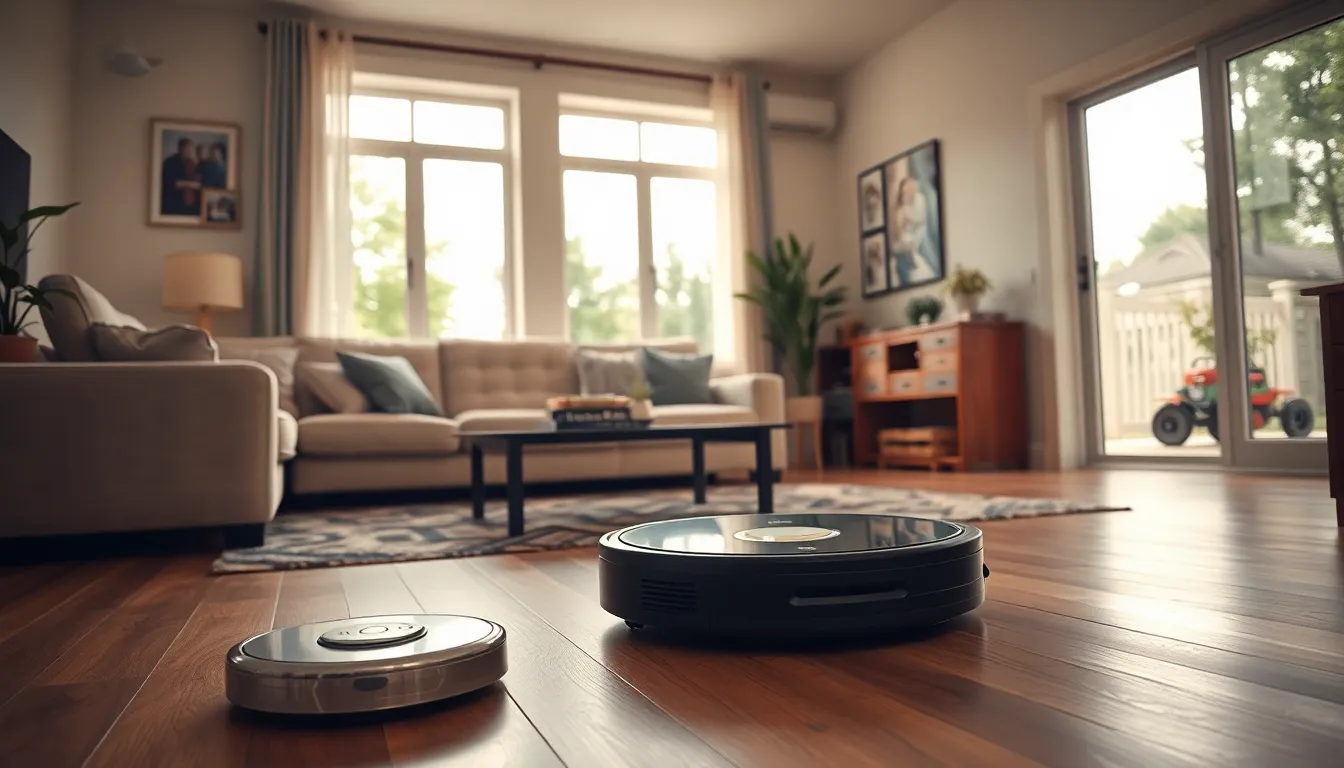Imagine a world where your coffee brews itself, your lights dim with a simple voice command, and your vacuum cleaner has a better social life than you do. Welcome to the age of robotics in home automation, where everyday chores become a thing of the past, and convenience reigns supreme.
As technology evolves, homes are transforming into smart sanctuaries, blending comfort with cutting-edge innovation. From robot assistants that can fetch your slippers to automated systems that manage your energy consumption, the possibilities are endless. Embracing robotics isn’t just about luxury; it’s about reclaiming time and sanity in an increasingly busy world. So, let’s dive into how these clever machines are revolutionizing home life, one automated task at a time.
Table of Contents
ToggleOverview of Robotics in Home Automation
Robotics plays a pivotal role in home automation, transforming living spaces into efficient environments. Smart robots perform tasks that once required manual labor, enhancing productivity. Automated systems integrate seamlessly with home devices, providing convenience at one’s fingertips. Tasks like cleaning, security monitoring, and energy management become simple with these innovations.
Robot vacuum cleaners exemplify the evolution of household chores, utilizing sensors and mapping technology to navigate efficiently. Smart security systems employ robotics to monitor properties, using cameras and AI to detect unusual activity. Energy management systems regulate energy consumption through adaptive algorithms, resulting in cost savings and environmental benefits.
The rise of voice assistants exemplifies the interaction between humans and machines. These devices control various home functions, allowing users to adjust lighting, thermostats, and appliances through verbal commands. These capabilities simplify everyday tasks, making homes more user-friendly.
Manufacturers are constantly improving robotic technologies, leading to enhanced functionality and integration. Each year, new devices enter the market, targeting specific needs, from elderly care solutions to childcare robotics. These advancements not only promote independence but also foster a safe and comfortable living environment.
Sustainability has emerged as a focal point in home automation. Smart robots contribute to energy efficiency by minimizing waste and optimizing resource use. Homeowners gain insights into energy use patterns, encouraging thoughtful consumption habits and a commitment to sustainability.
Robotics in home automation reflects a growing trend toward smart living. As technology advances, homes become increasingly interconnected and responsive to users’ needs. Embracing robotics enhances daily life significantly, transforming homes into modern sanctuaries of convenience and efficiency.
Benefits of Robotics in Home Automation

Robotics in home automation improves various aspects of daily living. Its advantages encompass efficiency and security, significantly impacting the modern household.
Increased Efficiency
Robots automate repetitive tasks, freeing up valuable time for families. Smart vacuum cleaners handle floor cleaning, while robotic mowers manage lawn care, eliminating manual labor. Automated systems streamline energy management, optimizing usage and reducing costs. Voice-controlled assistants enhance convenience, enabling users to adjust settings effortlessly. Task efficiency increases as robots operate consistently without fatigue. Time spent on household chores diminishes, allowing for more family engagement and leisure activities. Data shows that households can save up to 30% on time spent on chores through automation.
Enhanced Security
Smart robotic systems elevate home security significantly. Surveillance drones monitor landscapes, providing live updates and alerts on suspicious activity. Automated locking systems secure entrances, ensuring peace of mind when away from home. Motion detectors integrated with robot technology enhance responsiveness to intrusions. Advanced analytics assist in identifying potential breaches in real-time. These systems can run diagnostics, enhancing overall security protocols. Homeowners frequently express increased confidence about safety measures through robotic assistance. Security improvements can reduce burglaries by 20% in automated homes.
Key Technologies Driving Robotics in Home Automation
Robotic technologies dramatically enhance home automation, providing exceptional efficiency and control. Several key technologies underpin this transformation.
Artificial Intelligence
Artificial intelligence powers robots, enabling them to interact intelligently with users and their environments. AI helps systems recognize patterns, making them more adaptable and responsive in dynamic home settings. Smart assistants leverage AI to execute commands, remember user preferences, and even learn from past interactions. Many devices, including robotic vacuums, utilize AI algorithms for optimal cleaning routes, maximizing efficiency and effectiveness. This integration not only simplifies tasks but also elevates user experiences in everyday life.
Machine Learning
Machine learning facilitates continuous improvement in robotic systems, allowing them to analyze data and enhance performance over time. The technology enables robots to make informed decisions based on collected data from their surroundings. For instance, machine learning assists smart thermostats in adjusting temperature settings based on user habits and preferences. These systems not only improve comfort but also contribute to energy efficiency by optimizing usage patterns. As machine learning evolves, it distinguishes enhanced user interactions, creating a more intuitive home environment that adapts to individual needs.
Popular Robotics Applications in Home Automation
Robotics enhances home automation through various applications, significantly improving convenience and efficiency. Key examples include smart assistants and automated cleaning devices.
Smart Assistants
Smart assistants act as central hubs for controlling home devices. Users interact with these assistants via voice commands, which simplify daily tasks. Popular devices include Amazon Alexa, Google Assistant, and Apple HomePod. They manage lighting, temperature, and even security systems, offering customizable routines. Data shows that households using smart assistants can save approximately 15% of time on daily chores through automation. The integration of artificial intelligence enables these assistants to learn preferences and adapt, providing a smoother user experience. As they grow more intuitive, smart assistants play a crucial role in creating an interconnected home environment.
Automated Cleaning Devices
Automated cleaning devices revolutionize household chores by handling tasks like vacuuming and mopping. Devices such as Roomba and Braava allow users to maintain cleanliness without manual effort. These robots can navigate complex spaces and adjust cleaning patterns based on floor type. Many models are equipped with smart mapping technology, allowing for efficient cleaning paths that reduce time wasted. According to research, automated cleaning devices can save up to 30% of the time typically spent on cleaning duties. Such devices not only enhance convenience but also contribute to a healthier living environment by consistently removing dust and allergens.
Challenges and Limitations
High costs represent a significant challenge for homeowners interested in robotics for home automation. Prices for advanced robotic systems can exceed thousands of dollars, making initial adoption less accessible. Maintenance and repair for these devices also incur additional expenses, which can deter potential users from investing.
Safety concerns surrounding automation technologies warrant attention. Data privacy issues arise from the collection of user information by smart devices, creating a need for robust security measures. Furthermore, unreliable systems can lead to malfunction, posing safety risks when automated routines are in place.
Integration stands as another barrier to seamless home automation. Existing home infrastructure may not easily accommodate new robotic devices, requiring costly retrofitting. Compatibility among various smart home products can complicate usability, leading to user frustration.
Dependence on technology may create unexpected challenges. Relying heavily on robotic systems for daily tasks can result in reduced personal interaction and physical activity. Studies indicate that excessive dependence may contribute to a decline in essential life skills over time.
Limited adaptability can restrict performance in dynamic environments. Robots equipped with artificial intelligence often struggle with unexpected situations or changes in their surroundings. Inconsistent results may arise in environments with disruptive layouts, impacting overall efficiency.
A lack of standardized regulations also affects the robotics market in home automation. Varying safety standards and quality controls can lead to disparities in product performance. Consumers often face uncertainty about product reliability and effectiveness when evaluating options.
Addressing these challenges and limitations becomes essential for fostering the future growth of robotics in home automation. Creating solutions that prioritize affordability, safety, and adaptability will enhance the user experience, ultimately driving broader adoption.
Future Trends in Robotics for Home Automation
Innovations in robotics constantly reshape home automation, paving the way for smarter living. Expect advancements in AI-driven systems to enhance user interaction and efficiency. Increased focus on energy management fosters greater sustainability, as robots conserve resources while simplifying tasks.
Universal design principles aim to create more inclusive devices, making robotics accessible for elderly and disabled individuals. Enhanced data security measures will emerge as a critical requirement, protecting user information and privacy in interconnected homes.
Robot assistants will evolve to offer more personalized experiences through machine learning, adapting to individual preferences and habits. Expect trends toward multi-function robots, combining cleaning, monitoring, and security capabilities into single devices, streamlining home management.
Emerging technologies, like augmented reality, may integrate with robotic systems to provide real-time information and assistance in household tasks. Collaboration between various home automation platforms will ensure seamless interaction among devices, resulting in a cohesive smart home ecosystem.
Additionally, cost reduction in robotic manufacturing is likely, allowing wider consumer adoption of advanced technology. Increased affordability of robotic systems will engage more households, making automation a common aspect of daily life.
Societal shifts toward remote work will drive demand for automation solutions that maximize home productivity. As more people utilize home environments for multiple activities, robotics will create optimized spaces that support leisure, work, and relaxation simultaneously.
The integration of robotics in home automation is reshaping how people live and interact with their environments. As technology advances, homes are becoming more efficient and secure, allowing individuals to focus on what truly matters. The benefits of automation extend beyond convenience; they encompass enhanced safety and energy management, paving the way for a sustainable future.
While challenges remain, ongoing innovations and a growing emphasis on accessibility will drive wider adoption of these technologies. The future holds exciting possibilities for smarter living spaces that cater to diverse needs, making home automation an essential aspect of modern life. Embracing robotics not only transforms homes but also enriches daily experiences, creating a harmonious balance between technology and human interaction.


